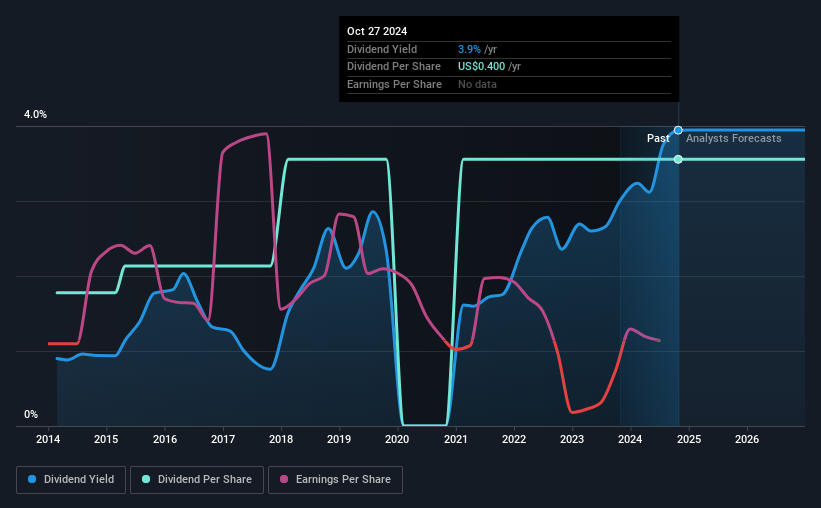Dana Incorporated's (NYSE:DAN) investors are due to receive a payment of $0.10 per share on 29th of November. This makes the dividend yield 3.9%, which will augment investor returns quite nicely.
See our latest analysis for Dana
Dana's Projections Indicate Future Payments May Be Unsustainable
Estimates Indicate Dana's Could Struggle to Maintain Dividend Payments In The Future
Dana's Future Dividends May Potentially Be At Risk
While it is great to have a strong dividend yield, we should also consider whether the payment is sustainable. Even while not generating a profit, Dana is paying out most of its free cash flows as a dividend. Generally paying a dividend without making profits isn't a great idea and we are also worried that there is limited reinvestment into the business.
Earnings per share is forecast to rise by 175.9% over the next year. However, if the dividend continues along recent trends, it could start putting pressure on the balance sheet with the payout ratio getting very high over the next year.

Dividend Volatility
The company has a long dividend track record, but it doesn't look great with cuts in the past. The annual payment during the last 10 years was $0.20 in 2014, and the most recent fiscal year payment was $0.40. This means that it has been growing its distributions at 7.2% per annum over that time. We have seen cuts in the past, so while the growth looks promising we would be a little bit cautious about its track record.
The Dividend Has Limited Growth Potential
With a relatively unstable dividend, it's even more important to see if earnings per share is growing. Over the past five years, it looks as though Dana's EPS has declined at around 48% a year. Such rapid declines definitely have the potential to constrain dividend payments if the trend continues into the future. On the bright side, earnings are predicted to gain some ground over the next year, but until this turns into a pattern we wouldn't be feeling too comfortable.
The Dividend Could Prove To Be Unreliable
Overall, it's nice to see a consistent dividend payment, but we think that longer term, the current level of payment might be unsustainable. The track record isn't great, and the payments are a bit high to be considered sustainable. We don't think Dana is a great stock to add to your portfolio if income is your focus.
Market movements attest to how highly valued a consistent dividend policy is compared to one which is more unpredictable. Still, investors need to consider a host of other factors, apart from dividend payments, when analysing a company. Taking the debate a bit further, we've identified 2 warning signs for Dana that investors need to be conscious of moving forward. Is Dana not quite the opportunity you were looking for? Why not check out our selection of top dividend stocks.
New: Manage All Your Stock Portfolios in One Place
We've created the ultimate portfolio companion for stock investors, and it's free.
• Connect an unlimited number of Portfolios and see your total in one currency
• Be alerted to new Warning Signs or Risks via email or mobile
• Track the Fair Value of your stocks
Have feedback on this article? Concerned about the content? Get in touch with us directly. Alternatively, email editorial-team (at) simplywallst.com.
This article by Simply Wall St is general in nature. We provide commentary based on historical data and analyst forecasts only using an unbiased methodology and our articles are not intended to be financial advice. It does not constitute a recommendation to buy or sell any stock, and does not take account of your objectives, or your financial situation. We aim to bring you long-term focused analysis driven by fundamental data. Note that our analysis may not factor in the latest price-sensitive company announcements or qualitative material. Simply Wall St has no position in any stocks mentioned.
About NYSE:DAN
Dana
Provides power-conveyance and energy-management solutions for vehicles and machinery in North America, Europe, South America, and the Asia Pacific.
Average dividend payer with moderate growth potential.
Similar Companies
Market Insights
Community Narratives



